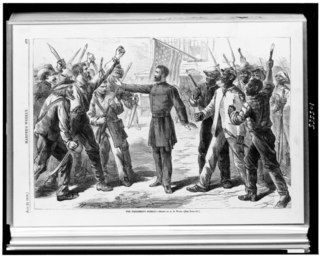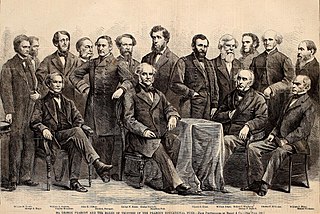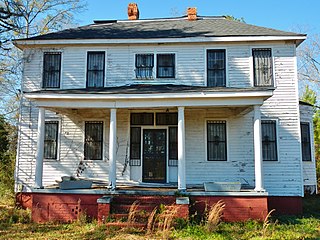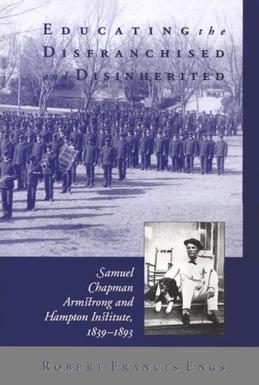
Booker Taliaferro Washington was an American educator, author, and orator. Between 1890 and 1915, Washington was the primary leader in the African-American community and of the contemporary Black elite.

Jabez Lamar Monroe Curry was an American Democratic politician from Alabama who served in the state legislature and US Congress. He also served as an officer of the Confederate States Army in the American Civil War. He was a slave owner and supported the Southern cause.

Tuskegee University is a private, historically black land-grant university in Tuskegee, Alabama. It was founded on July 4th in 1881 by the Alabama Legislature.

The Bureau of Refugees, Freedmen, and Abandoned Lands, usually referred to as simply the Freedmen's Bureau, was a U.S. government agency of early post American Civil War Reconstruction, assisting freedmen in the South. It was established on March 3, 1865, and operated briefly as a federal agency after the War, from 1865 to 1872, to direct "provisions, clothing, and fuel... for the immediate and temporary shelter and supply of destitute and suffering refugees and freedmen and their wives and children".

Hampton University is a private, historically black, research university in Hampton, Virginia. Founded in 1868 as Hampton Agricultural and Industrial School, it was established by Black and White leaders of the American Missionary Association after the American Civil War to provide education to freedmen. The campus houses the Hampton University Museum, which is the oldest museum of the African diaspora in the United States and the oldest museum in the commonwealth of Virginia. First led by former Union General Samuel Chapman Armstrong, Hampton University's main campus is located on 314 acres in Hampton, Virginia, on the banks of the Hampton River.

The Peabody Education Fund was established by George Peabody in 1867, after the American Civil War, for the purpose of promoting "intellectual, moral, and industrial education in the most destitute portion of the Southern States" except schools for newly freed African Americans. The main purpose of the fund was to aid elementary education by strengthening existing schools. Because it was restricted from founding new schools, it largely did not benefit freedmen in the South; only 6.5% of its disbursements went to schools for Black students in its early years. The gift of foundation consisted of securities to the value of $2,100,000, of which $1,100,000 were in Mississippi State bonds, afterward repudiated.

John Fox Slater was an American philanthropist who supported and funded the education of freedmen after the Civil War.

Emancipation Oak is a historic tree on the campus of Hampton University in Hampton, Virginia, in the United States. The large, sprawling southern live oak, believed to be over 200 years old, is 98 feet in diameter, with branches which extend upward as well as laterally. It is designated one of the 10 Great Trees of the World by the National Geographic Society and is part of the National Historic Landmark district of Hampton University.
The Southern Education Foundation (SEF) is a not-for-profit foundation created in 1937 from four different funds — the Peabody Education Fund, the John F. Slater Fund, the Negro Rural School Fund, and the Virginia Randolph Fund. Their main goal is to promote quality education for traditionally disadvantaged students, including the poor and African Americans. SEF provides research, policy analysis and programming in Alabama, Arkansas, Florida, Georgia, Kentucky, Louisiana, Maryland, Mississippi, North Carolina, Oklahoma, South Carolina, Tennessee, Texas, Virginia, and West Virginia. Raymond C. Pierce is the current president.

Richard Robert Wright Sr. was an American military officer, educator and college president, politician, civil rights advocate and banking entrepreneur. Among his many accomplishments, he founded a high school, a college, and a bank. He also founded the National Freedom Day Association in 1941.
The Grand Contraband Camp was located in Elizabeth City County, Virginia, on the Virginia Peninsula near Fort Monroe, during and immediately after the American Civil War. The area was a refuge for escaped slaves who the Union forces refused to return to their former Confederate masters, by defining them as "contraband of war". The Grand Contraband Camp was the first self-contained black community in the United States and occupied the area of the downtown section of the present-day independent city of Hampton, Virginia.
The Jeanes Foundation, also known as the Negro Rural School Fund or Jeanes Fund, helped support education and vocational programs for African American in rural communities from 1908 to the 1960s. It was founded by Anna T. Jeanes with help from Booker T. Washington in 1907.

The Calhoun Colored School (1892–1945), was a private boarding and day school for Black students in Calhoun, Lowndes County, Alabama, about 28 miles (45 km) southwest of the capital of Montgomery. It was founded in 1892 by Charlotte Thorn and Mabel Dillingham, from New England, in partnership with Booker T. Washington of Tuskegee Institute, to provide education to rural black students. African Americans comprised the majority in this area, and the state had segregated facilities. Calhoun Colored School was first designed to educate rural black students according to the industrial school model common at the time.
Jackson Davis was a principal, education official, and education reformer from Virginia during the Jim Crow era of segregation. He was involved in supervising education programs for African Americans and promoted well maintained manual labor colleges for them. He did not express any opposition to segregation. He took photographs and documented conditions at some of the schools serving African Americans and Native Americans in the southern United States, especially in rural areas. He was also involved with philanthropic organizations, traveled to Africa twice, and was part of a colonization society.
The civil rights movement (1865–1896) aimed to eliminate racial discrimination against African Americans, improve their educational and employment opportunities, and establish their electoral power, just after the abolition of slavery in the United States. The period from 1865 to 1895 saw a tremendous change in the fortunes of the Black community following the elimination of slavery in the South.

Educating the Disfranchised and Disinherited is a 1999 biography of American General Samuel Chapman Armstrong and his associated normal school for freedmen, Hampton Institute, written by Robert Francis Engs and published by the University of Tennessee Press. The first full biography of its kind, the book portrays Armstrong as a complex politician and administrator in the postbellum period who balanced the needs of opposed parties surrounding the Virginia school: its African American students, Southern white neighbors, and Northern philanthropist funders. Previous works presented Armstrong in a polarized fashion, as either a savior or handicap for freedmen. The book emphasizes Armstrong's upbringing as a missionary in Hawaii in the development of his educational philosophy.

Hollis Burke Frissell was an American chaplain and college president. He served as the second president of Hampton Institute.

The Hampton Negro Conference was a series of conferences held between 1897 and 1912 hosted by the Hampton Institute in Hampton, Virginia. It brought together Black leaders from across the Southern United States, as well as some white participants, to promote, analyze, and advertise the progress of Black Americans. According to a description in the Institute's catalog, through the conferences "a general summary of the material and intellectual progress of the Negro race [was] obtained."
History of education in the Southern United States covers the institutions, ideas and leaders of schools and education in the Southern states from colonial times to about the year 2000. It covers all the states and the main gender, racial and ethnic groups.
The History of African-American education deals with the public and private schools at all levels used by African Americans in the United States and for the related policies and debates. Black schools, also referred to as "Negro schools" and "colored schools", were racially segregated schools in the United States that originated in the Reconstruction era after the American Civil War. They were created in Southern states under biracial Republican governments as free public schools for the formerly enslaved. All their students were blacks. After 1877, conservative whites took control across the South. They continued the black schools, but at a much lower funding rate than white schools.













